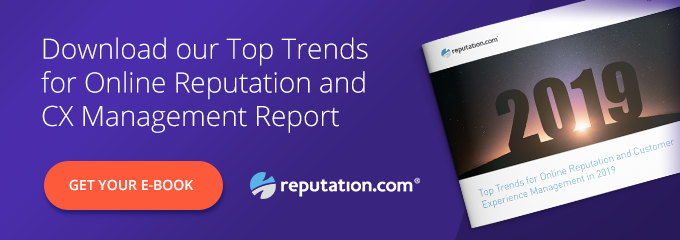CX Game Changes as New Customer Journey Levels the Field
Reputation Staff Writer

This post was originally published on LinkedIn. Click to follow Reputation.com on LinkedIn.
Unlike the Super Bowl this year, the battle for customers is about to get interesting. That’s because the playing field between brands and customers has been leveled. With constant access to information — and more power to influence branding — consumers, and their opinions, hold the power to shape brand awareness and reputation.

Welcome to the Future
Remember the good ‘ol days? Back when I was a kid, we spent most of the day outside, because we only had three TV channels. While we were drinking from hoses, playing with BB guns and staying out until the streetlights came on, our parents were getting their information from TV and radio ads. Google didn’t exist — they had to rely on the Yellow Pages to research a business. The really big brands could afford billboards. Information came to us in these passive ways, and we trusted it.
Well, no one trusts advertising anymore. Now, we rely on reviews and social media for the information we need to make choices about where to spend our hard-earned money. Traditional word of mouth — which was relatively slow-moving and typically confined to small groups of people — has been upgraded and magnified with online reviews, social media and other forms of rapid information exchange. Just look at these stats:
- Over 90% of consumers trust reviews as much as a personal recommendation.
- Ninety-five percent of customers will read reviews before making a selection.
- Eighty-eight percent of consumers have avoided a company because of a bad review on social media.
- Consumers read an average of 10 online reviews before they even begin to trust a local business.
- Reviews older than 3 months aren’t considered relevant.
- Among 200+ local ranking factors that affect visibility in Google’s local pack, 9 of the top 10 ordinal variables are reviews.
The digital revolution has put the world in a state of constant awareness, and consumers are empowered to make informed decisions with a supercharged ability to search, research, compare and comment. Now, a single individual’s good or bad experience with a brand has the power to sway the opinions of the masses. One tweet, retweeted a few times, can reach hundreds of thousands of consumers in minutes, instantly impacting even the most proven of brands. It’s no longer “They’ll tell two friends, and they’ll tell two friends, and so on and so on” — it’s “he tweets and thousands retweet, and the whole world knows by tomorrow morning.”
This rapid information exchange has a tremendous impact on how we do business. Sales cycles are shorter. The purchasing process is easier. Feedback loops are completely transparent. The result? Consumer advocacy is a moving target. In fact, the customer journey itself is no longer linear. It twists and turns at every customer touchpoint — from the first Google search through the most recent post-sale interaction — and your customer can go in any direction, at any time.
Here’s an example. You’ve purchased multiple vehicles from a particular car dealership over the years, and you have nothing but good things to say about them. Then one day, you take your key fobs in because the batteries are running low. You give them both to the service department. When you return to pick them up, the service manager claims you only provided one fob and charges you extra to replace the second. Although that’s one of 20 or more interactions you’ve had with the dealership, it affects your perception. Every previous interaction may have warranted five stars, but this interaction was one star (at best). Now your overall rating might be 4.5 stars. A single negative interaction such as this can and will impact a business’s overall reputation with even the most loyal customers.

Today’s customer journey is non-linear. Advocacy for a brand forms at any and all stages, from awareness and research through purchase and consumption. The customers’ truth — what they think about your brand — can change at any point along the way.
How Do We Enable Success in a Non-linear Customer Journey?
If you’re not actively managing every single step of your buyer’s journey simultaneously, you’re missing the boat — and the opportunity to close and retain business. You have to tune in to how customers interact with your brand and its promise at every single touchpoint.
Unfortunately, most businesses don’t have the technology in place to collect and analyze data from those individual touchpoints as a whole. As a result, they lack insight into what people think and say about their brand in a way that enables them to close the feedback loop — and take action to fix things that are causing customers to take their money elsewhere. This data — what I call “data in the wild” — holds the key to improving customer experience and business operations — and, ultimately, better business outcomes.
I joined Reputation.com for this very reason. The Reputation.com platform was designed with the new customer journey in mind, and it enables the business world to meet the challenges of the new customer journey head-on. We empower companies to make customer-focused decisions in real-time, and our platform can fundamentally change how businesses transform experiences. We enable our customers to amplify their reputation, loyalty and advocacy through powerful actionable and data-based insights.
Data Runs Wild — But Here’s How to Tame It
This post is the first in a series, in which I’ll look at how businesses collect and analyze customer feedback now, and what has to change to keep pace with a non-linear buyer’s journey that is fueled by real-time data from multiple digital sources.
My next post in the series will examine the power of unstructured data in the wild to create the evolving “customer truth,” and how it holds the secret to better CX, more sales and business growth.

